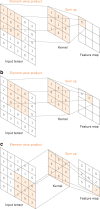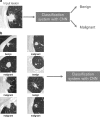Convolutional neural networks: an overview and application in radiology
- PMID: 29934920
- PMCID: PMC6108980
- DOI: 10.1007/s13244-018-0639-9
Convolutional neural networks: an overview and application in radiology
Abstract
Convolutional neural network (CNN), a class of artificial neural networks that has become dominant in various computer vision tasks, is attracting interest across a variety of domains, including radiology. CNN is designed to automatically and adaptively learn spatial hierarchies of features through backpropagation by using multiple building blocks, such as convolution layers, pooling layers, and fully connected layers. This review article offers a perspective on the basic concepts of CNN and its application to various radiological tasks, and discusses its challenges and future directions in the field of radiology. Two challenges in applying CNN to radiological tasks, small dataset and overfitting, will also be covered in this article, as well as techniques to minimize them. Being familiar with the concepts and advantages, as well as limitations, of CNN is essential to leverage its potential in diagnostic radiology, with the goal of augmenting the performance of radiologists and improving patient care. KEY POINTS: • Convolutional neural network is a class of deep learning methods which has become dominant in various computer vision tasks and is attracting interest across a variety of domains, including radiology. • Convolutional neural network is composed of multiple building blocks, such as convolution layers, pooling layers, and fully connected layers, and is designed to automatically and adaptively learn spatial hierarchies of features through a backpropagation algorithm. • Familiarity with the concepts and advantages, as well as limitations, of convolutional neural network is essential to leverage its potential to improve radiologist performance and, eventually, patient care.
Keywords: Convolutional neural network; Deep learning; Machine learning; Medical imaging; Radiology.
Figures

















Similar articles
-
Deep Learning: A Primer for Radiologists.Radiographics. 2017 Nov-Dec;37(7):2113-2131. doi: 10.1148/rg.2017170077. Radiographics. 2017. PMID: 29131760 Review.
-
Joint multiple fully connected convolutional neural network with extreme learning machine for hepatocellular carcinoma nuclei grading.Comput Biol Med. 2017 May 1;84:156-167. doi: 10.1016/j.compbiomed.2017.03.017. Epub 2017 Mar 22. Comput Biol Med. 2017. PMID: 28365546
-
Deep learning with convolutional neural network in radiology.Jpn J Radiol. 2018 Apr;36(4):257-272. doi: 10.1007/s11604-018-0726-3. Epub 2018 Mar 1. Jpn J Radiol. 2018. PMID: 29498017 Review.
-
Low-Rank Deep Convolutional Neural Network for Multitask Learning.Comput Intell Neurosci. 2019 May 20;2019:7410701. doi: 10.1155/2019/7410701. eCollection 2019. Comput Intell Neurosci. 2019. PMID: 31236107 Free PMC article.
-
Diagnostic performance for pulmonary adenocarcinoma on CT: comparison of radiologists with and without three-dimensional convolutional neural network.Eur Radiol. 2021 Apr;31(4):1978-1986. doi: 10.1007/s00330-020-07339-x. Epub 2020 Oct 4. Eur Radiol. 2021. PMID: 33011879
Cited by
-
Advancements and Challenges in the Image-Based Diagnosis of Lung and Colon Cancer: A Comprehensive Review.Cancer Inform. 2024 Oct 16;23:11769351241290608. doi: 10.1177/11769351241290608. eCollection 2024. Cancer Inform. 2024. PMID: 39483315 Free PMC article. Review.
-
Advanced federated ensemble internet of learning approach for cloud based medical healthcare monitoring system.Sci Rep. 2024 Oct 30;14(1):26068. doi: 10.1038/s41598-024-77196-x. Sci Rep. 2024. PMID: 39478132 Free PMC article.
-
A review of deep learning-based reconstruction methods for accelerated MRI using spatiotemporal and multi-contrast redundancies.Biomed Eng Lett. 2024 Sep 17;14(6):1221-1242. doi: 10.1007/s13534-024-00425-9. eCollection 2024 Nov. Biomed Eng Lett. 2024. PMID: 39465106 Free PMC article. Review.
-
Feature Reviews for Tomography 2023.Tomography. 2024 Oct 9;10(10):1605-1607. doi: 10.3390/tomography10100118. Tomography. 2024. PMID: 39453035 Free PMC article.
-
Equilibrium Optimization-Based Ensemble CNN Framework for Breast Cancer Multiclass Classification Using Histopathological Image.Diagnostics (Basel). 2024 Oct 9;14(19):2253. doi: 10.3390/diagnostics14192253. Diagnostics (Basel). 2024. PMID: 39410657 Free PMC article.
References
-
- Russakovsky O, Deng J, Su H, et al. ImageNet Large Scale Visual Recognition Challenge. Int J Comput Vis. 2015;115:211–252. doi: 10.1007/s11263-015-0816-y. - DOI
-
- Krizhevsky A, Sutskever I, Hinton GE (2012) ImageNet classification with deep convolutional neural networks. Adv Neural Inf Process Syst 25. Available online at: https://papers.nips.cc/paper/4824-imagenet-classification-with-deep-conv.... Accessed 22 Jan 2018
Publication types
Grants and funding
LinkOut - more resources
Full Text Sources
Other Literature Sources


